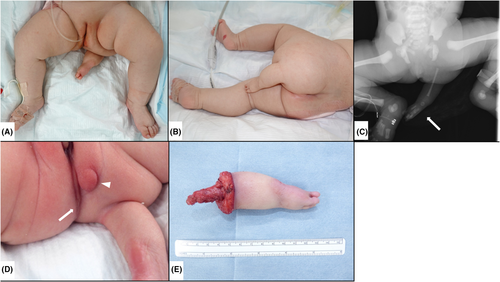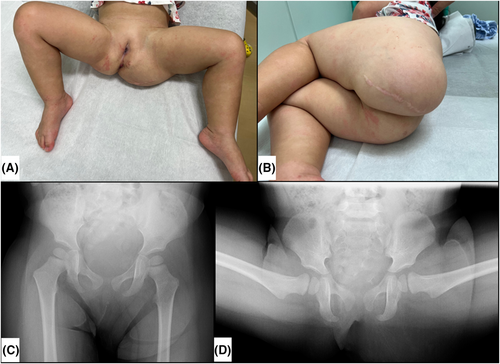Congenital incomplete duplication of lower extremity (polymelia) accompanied with anorectal malformation and unilateral deafness
Y. Shinden and M. Hakozaki contributed equally to this paper.
Key Clinical Message
Polymelia (supernumerary limbs) is an extremely rare congenital condition in humans. Because congenital anorectal malformation is a relatively common complication of polymelia and it may require emergency surgery as in the present case, accompanying malformations must be investigated.
1 CASE PRESENTATION
The patient's parents had no significant personal or family medical history, and the pregnancy passed without notable complications. Periodic prenatal ultrasound examination findings showed no visible malformations at a nearby obstetric clinic. When the patient was born at 38 weeks of pregnancy, with 1- and 5-min Apgar score of 8 and 9, respectively, an incomplete supernumerary limb was observed attached to her left buttock (Figure 1A–C). Moreover, an anorectal malformation (high level of rectal end with rectovestibular fistula) and a small subcutaneous mass were also found (Figure 1D) upon further examination. She was immediately referred to our hospital and an emergency colostomy was performed on the same day. Four days after birth, left deafness was detected using automated auditory brainstem response. Radiological examination revealed an incompletely duplicated left limb. Plain radiographs showed two ossification centers behind the ischium, a thin femur, talus, and three metatarsals and phalanges (Figure 1C). Developmental dysplasia of the bilateral hip joints was excluded on CT. Although a slight sacrococcygeal deviation to the right was observed, malformations of the other pelvic bones and bilateral femurs were not observed. Magnetic resonance imaging revealed a neurovascular bundle parallel to the thin femur. Two months after birth, the extra leg, including the two ossification centers in the buttocks, was resected (Figure 1E). The feeding vessels and nerves were resected after ligation around the ossification center. The excess skin and subcutaneous fat were removed. After surgery, there was no difference in the leg length. Pathologically, the bone and cartilaginous structures in the resected extra leg were mature. Six months after birth, posterior sagittal anorectoplasty and resection of the perineal subcutaneous mass, later diagnosed with a fibroadipose tissue, were performed. Cystostomy closure was performed 10 months after birth. Twenty-four months after birth, the patient could walk by herself, and no evident psychomotor seizures or language delay were observed (Figure 2).


Although polymelia (supernumerary limbs) is frequently reported in animals, it is an extremely rare congenital condition in humans with only a limited number of cases reported to date.1 Although various adverse embryogenic factors have been speculated to be responsible for polymelia, its pathogenesis remains obscure in most cases. Among the previously reported cases, several accompanying malformations were observed; in particular, congenital anorectal malformation is a relatively frequent complication of polymelia, such as an ectopic anus, a persistent cloaca, or an imperforate anus, as in our patient.1 In our patient, the accompanying anorectal malformation required emergency surgery. The utility of ultrasound in detecting prenatal polymelia has recently been reported.2, 3 Although prenatal diagnosis was not possible in our patient, accompanying malformations must be investigated when polymelia is suspected on prenatal ultrasound examination.
AUTHOR CONTRIBUTIONS
Yumetaka Shinden: Conceptualization; data curation; writing – original draft. Michiyuki Hakozaki: Conceptualization; data curation; methodology; writing – original draft; writing – review and editing. Shun Hiruta: Data curation; validation; writing – review and editing. Hideaki Tanaka: Data curation; supervision; validation; writing – review and editing. Yoshihiro Matsumoto: Supervision; validation; writing – review and editing.
FUNDING INFORMATION
This study did not receive any specific grants from funding agencies in the public, commercial, or not-for-profit sectors.
ETHICS STATEMENT
At our institution, case reports do not require ethics review committee approval.
CONSENT
Written informed consent was obtained from the patient's parents to publish this report in accordance with the journal's patient consent policy.
Open Research
DATA AVAILABILITY STATEMENT
All data supporting the findings are available within themanuscript.




